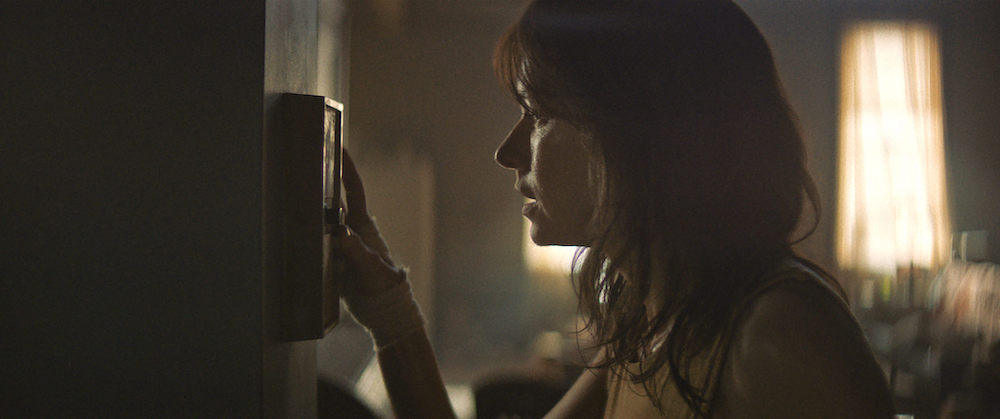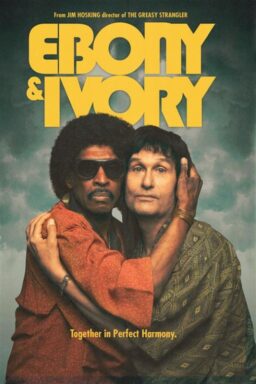Naomi Watts further proves that she’s one of the best with “The Wolf Hour,” a largely one-woman show directed by Alistair Banks Griffin that takes place in a sweaty, anxious New York City during the Summer of Sam. Watts is a major factor to the charisma of this movie, expressing her character’s isolation and anxiety; she makes each mysterious buzz on her apartment all the more nervous, and her conditions are the more visceral.
Watts plays June, an author who has essentially holed herself up in the apartment of her late grandmother. There’s an air of chaos outside, with a serial killer on the loose who terrorizes women that look just like her. Every now and then, someone mysteriously buzzes her apartment, making her all the more uncomfortable, and us too. Watts has a peacefulness when she is not disturbed, but then a vivid sense of chaos when it comes to watching the violence unfolding on the streets below her. The cinematography by Khalid Mohtaseb captures the darkness and the griminess of the apartment, ambitiously dangling the film over the edge of being too bland but finding specific light and texture to make the film visually dynamic.
Griffin’s script works through a great deal of atmosphere in some of its passages, and threatens to be inert if not plotless in some passages. But it gains energy when it needs to by bringing in additional characters played by the likes of Emory Cohen and Kelvin Harrison Jr., and slowly revealing the past that has made her afraid to go outside. Watts is so strong in this part that even an exposition-heavy moment in which she watches her previous self in interview still contains nuance, mystery.
The atmospheric ambitions of the story only falter by the end, as “The Wolf Hour” doesn’t wrap itself up with brilliance in its 15 minutes. But as “The Wolf Hour” is engrossing for much of its anxious timeline, it’s the inner journey Watts provides that sticks with you most of all.

“Selah and the Spades” tells a story of high school factions, building a world out of a quintet of high school cliques in a fancy boarding school. In the style of “Dear White People” and “School Daze” before it, the story centers on a group of kids getting caught in some dirty business, and making up their own rules. Selah (Lovie Simone) is the leader of a group called the Spades, and she incorporates Paloma, a new member into her group (Celeste O'Connor), younger and more naive, but malleable. Paloma becomes our surrogate into the goings-on and the power struggles.
“Selah and the Spades” shows a great deal of promise for writer/director Tayarisha Poe, who demands your attention with style and story in her directorial debut. Some sequences can really pop, as with a center-framed monologue in which Selah talks about her agency as a cheerleader. But the inconsistent energy makes its more dialogue and plot-driven fragments about drug-dealing feel like a crash from a sugar rush.
More than its sporadic practical effects (like a stairway covered in glasses of different-colored water, or neon lights in the woods), the film’s most consistent style comes from former Ebert Fellow Jomo Fray’s cinematography. He elevates the reality of this story through tilted angles, negative space, and the center framing. It’s a great example of how cinematography can influence storytelling, and how being thoughtful with framing can affect how the overall presentation lingers.

“Adam” is a headache of a movie, however great its intentions. Here’s the pitch: a young cisgender white kid named Adam (Nicholas Alexander) goes to New York City to spend the summer with his older, queer sister Casey (Margaret Qualley), and witnesses the LGBTQ+ scene. But he pretends to be a transgender man when a queer woman (Bobbi Salvör Menuez) he’s smitten with is convinced he’s trans. We spend much of “Adam” waiting for his ridiculous, insensitive lies to be called out.
If your eyes rolled out of your head reading that, that’s fair. This premise (adapted by Ariel Schrag from her book) very likely wouldn’t work at all if it didn’t prominently feature so many transgender actors, or if it hadn’t been directed by a transgender director. Thankfully, this is not the mean-spirited sex comedy that could have been made from a similar concept in previous Hollywood eras. But “Adam” is a textbook example of the quandary behind progress with representation—does a movie make up for its shallow center focus by showing people on-screen who rarely get the screen-time, giving them cinematic lives? Or is “Adam” still just as bad because we spend so much of it with a nauseating protagonist?
“Adam” is given a smoothness from promising director Rhys Ernst, making his directorial debut. The film is always in control of its tone, whether it’s in the studio teen comedy-esque beats, or cringing moments in which the dunderhead nonetheless learns a bit more about someone else’s life experience. But it just becomes so cringeworthy to see Adam become the main focus of the story, especially as the side characters reveal themselves to be more interesting and frustrating. Adam takes a clumsy journey to enlightenment, but at what cost? I wanted more of the characters outside of his cheap con, like his sister Casey, new confidant and Film Forum employee Ethan (Leo Sheng), temporary roommate June (Chloe Levine) and other characters who appear in the parties, clubs, and campgrounds that Adam navigates.
I have no idea who will find this movie offensive, but at the end of the day I do think the film deserves an audience—a far-reaching entity like Netflix should pick this up—so that viewers can at least see a whole bunch of actors who are talented but also gravely underrepresented in film. I can’t wait to read the critical and supportive pieces that are bound to be written about it.

“Premature” is an excellent showcase for future-star Zora Howard, who co-wrote this script with director Rashaad Ernesto Green. It largely concerns a summer in the life of Ayanna (Howard), a 17-year-old girl who is intelligent and focused, and has an electric group of friends we sporadically get to hang out with. Ayanna’s life is thrown for a bit of a loop when she meets a music producer Isaiah (Joshua Boone), a slightly older man who seems worthy of her time, and quickly woos her. The film emphasizes the romance of their relationship with its Kodak 16mm cinematography, which offers a dreaminess to the scenes of them sharing intimate New York sights with each other, and a great classic grain to its flat-out sexy passages.
As the script takes place in the different days of Ayanna, sometimes it can force along its conflicts with convenient timing, like when an ex-girlfriend of Isaiah’s suddenly pops into the frame. But for the most part, the story works through some of its potential melodrama with finesse and truth, making some of its more developments feel like normal affectations of Ayanna’s most dramatic summer yet.
As it gently moves from one major life experience to the next, Green and Howard are the crucial forces that help make “Premature” feel so wise while telling its delicate story of coming-of-age. The movie gets its charisma from its lived-in moments, the scenes that are filled with her friends razzing each other, or show Ayanna finding ways to take on the world’s latest curve ball. Like the love expression Ayanna later co-writes for Isaiah, “Premature” is a tender ballad—not just about love but age, opportunity, timing—that gets stuck in your head.

“Sister Aimee” is inspired by bizarre a true story, but it doesn’t take full advantage of the incredible factors within it. Anna Margaret Hollyman plays the evangelist and swindler Sister Aimee, who, as this story goes, raised a bunch of money from people by pretending to heal people, and then faked her own death in 1926. But this script from co-directors and co-writers Samantha Buck and Marie Schlingmann takes a less exciting approach to her disappearance, and reveals bits of her past in flat scenes where characters are interviewed by police. There is also a surprising focus on a badass woman named Rey (Andrea Suarez Paz), who helps Sister Aimee and her lover in their journey to Mexico, but the character details exist as if to fill in time.
There’s a lot of missed opportunity here, especially with how the story admits in opening texts that it is playing with fact and fiction. The script is more about the getaway of an enigmatic con-woman, trying to be light on its feet and dysfunctional like a Coen brothers period piece, and it just doesn’t have as much energy. “Sister Aimee” hits its desired absurdist note when Hollyman gets a song-and-dance number, but that’s at the very end. But it’s too late, as “Sister Aimee” is far from the film you had originally hoped it would be.












